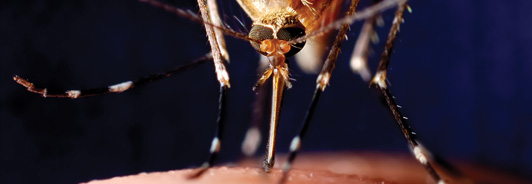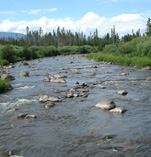Brian Geiss and Susan Keenan sat down to dinner seven years ago to celebrate and catch up.
It was a happy time for the friends who met in graduate school at St. Louis University’s School of Medicine. Geiss had a good job teaching and researching mosquito and tick-borne viruses at Colorado State University. Keenan’s husband, Kirk, had landed a pharmaceutical job in Boulder, meaning he and Susan could move to Colorado, where they spent their vacations rock climbing.
As the dinner conversation turned to science, Keenan and Geiss discovered they would be a good fit as research partners. They didn’t work out all the details that night, but they decided they would work together to combat flaviviruses, a group of 35 illnesses spread by mosquitoes or ticks. Geiss was already researching those because of West Nile virus, which has now infected thousands and killed hundreds in the United States since 2002 when the first major outbreak occurred.
Now when the two get together, usually in Keenan’s office at UNC, where she is an associate professor and director of the School of Biological Sciences, they still talk like old friends. They can easily get roped into conversations about what was more epic (their word), Star Wars or Lord of the Rings. But they also talk business.
As it turns out, their unusual approach in the last year led to a major breakthrough in defeating West Nile, and it may not only one day end fears of the disease: It may just wipe out the worries of the millions of people in danger of being infected, or killed, by viruses spread by mosquitoes or ticks around the world.
• • •
“Fresh cells served daily. Viruses dine free.”
You’ll see that written above one of the workspaces in Geiss’ lab at CSU. The words, of course, show the sense of humor the two share.They love to joke that they are “scientifically married.”
But the words in Geiss’ lab, even if they are funny, aren’t a joke. Scientists consider flaviviruses a priority because they cause life-threatening illnesses, and there aren’t many vaccines to prevent someone from getting them or, even worse, treatments for them once someone gets sick.
For those reasons, and given potential use as biological weapons, the National Institutes of Health considers a number of flaviviruses “priority pathogens.” That includes dengue fever, which kills 20,000 a year in tropical climates, where the mosquito thrives.
The 2012 West Nile outbreak had the highest number of total cases since 2003. The disease was reported in all 48 continental states, and Texas declared a state of emergency.
Geiss and Keenan didn’t want to develop a single vaccine for West Nile, however. After all, as Geiss likes to joke during his class lectures, why develop a bullet that could kill a single zombie, when you could find something to end the apocalypse?
Their idea was to inhibit, if not stop, the viruses from replicating by binding a compound to a protein the viruses needed to make copies of themselves in the body, which is ultimately how a virus makes us sick. Some of the work was already done for them: That protein, which seemed to exist in similar form among all the flaviviruses, had already been discovered.
The beauty of it, both say, is their method reduces the viruses’ “soldiers” from a large army to a small squadron. So our soldiers, our white blood cells, have much better odds against whatever the mosquito gives us, whether that’s West Nile or another flavivirus. It also would give doctors a way to treat the virus once it infects someone. Of the 35 in the flavivirus category, only three have any kind of vaccine.
The intriguing idea won them a two-year development project from the Rocky Mountain Regional Center for Excellence at CSU. That didn’t leave them much time to prove their theory had promise, even when the center gave them another five-year deal after their initial probation period.
“There’s always pressure with funding,” Keenan says. “It’s very competitive. You have to show results.”
In six years, the two were able to map how the enzyme works in the viruses’ replication, and, more importantly, to find a promising drug to stop it. They believe the drug will work on all the flaviviruses, though the work against West Nile was what got attention.
Even so, there’s a lot more testing that needs to take place, including in live animals. They’ll start with mice. Not zombies.
• • •
As you’ve probably guessed, Geiss’ and Keenan’s work relationship is as symbiotic as those little birds that clean a crocodile’s teeth and get a meal in return.
Keenan, a chemist and molecular biologist, works in computer-aided drug design, and Geiss specializes in the lab, with a knack for flaviviruses. Keenan develops computer models that help her project how a drug might work against a disease and predicts what might work better than others. Geiss tests it in a lab, then tells her the results and tells her why it did (or in many cases didn’t) work. She tweaks the formula.
Before that, though, Keenan and Geiss both went to Harvard, where they blitzed the virus’ protein with hundreds of thousands of compounds to give them a framework on what might inhibit it from replicating. Once they narrowed the field to some promising candidates, which took more than a year, they began their work on finding the right one.
It’s a delicate matter. They had to find a compound that could get through the membrane of the West Nile infected cells and find a way to inhibit the protein without destroying the cells it was trying to protect.
After withstanding the ups and downs that come with testing, including false negatives and false positives (which are infinitely worse, given the hopes they raise), their Eureka moment came when they found a compound they liked, then tested it on the live virus. The compound worked even better on the protein than they had hoped: One of the molecules they found was able to reduce virus replication in cells by more than a thousandfold. And it worked in several different viruses, exactly as hoped.
• • •
Developing a clinical drug — one that could be taken by humans — could take years, even a decade. In the meantime, Geiss and Keenan have filed a provisional patent with CSU Ventures to commercialize the technology.
“To be honest, most people have already been infected by West Nile,” Geiss says. “But there are people who continue to get sick.”
West Nile, for now, is a serious illness, and it could stay that way, too. In general, those who did get sick last year had more severe neurological symptoms than doctors were used to seeing. Those who were sick in the past still struggle as well: Geiss has a neighbor who got it several years ago but still has vision problems.
And with climate change, the possibility of other viruses, such as dengue fever, reaching more parts of the world rises with the temperatures, Keenan says. Dengue fever — which has ravaged Asia and Africa — has been identified in both Florida and Hawaii.
“I look at this as broader than West Nile,” Keenan says. “The global impact of flaviviruses is all about where the mosquitoes are able to replicate.”
Their work is serious, sure, but if, say, a conversation about zombies slips in there, well, that’s OK, too.
“We can really communicate with each other because we are friends,” Keenan says. “It supersedes the science. I can say to him, ‘Oh, come on,’ without being rude.”






